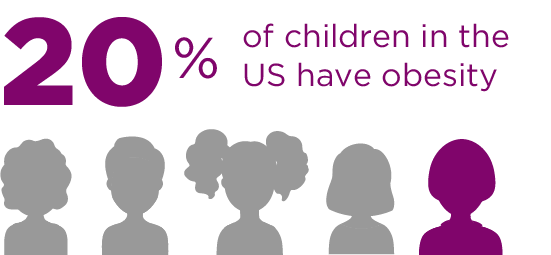Section
1
Introduction
Background
You may be here because you are aware that childhood obesity in the United States is a serious problem and want to be part of the solution to help prevent and reduce childhood obesity.

Obesity is defined using body mass index (weight in kilograms divided by the square of the height in meters [BMI]) at or above the 95th percentile of the CDC sex-specific BMI-for-age growth charts.1 Results from the 2017–2018 National Health and Nutrition Examination Survey (NHANES) indicate that an estimated 19.3% of U.S. children and adolescents aged 2–19 years have obesity.2 Childhood obesity also disproportionately affects some racial and ethnic minority populations, with Hispanic and non-Hispanic Black children having higher obesity prevalence than non-Hispanic white children.1
In 2017, the USPSTF provided a grade B recommendation for screening for weight status in children and adolescents and offering or referring to intensive behavioral intervention programs.3 Intensive programs were defined as delivering ≥ 26 hours of intervention contact time over a 2–12 month period. Adherence to evidence-based program recommendations and understanding and addressing the systemic root causes are critical to achieving positive outcomes. However, you may need guidance on how to determine whether your program is achieving its goals. If this sounds like you, then this toolkit may be able to help you enhance your knowledge and skills in evaluating childhood healthy weight programs.
Toolkit Overview
Program evaluation is a fundamental component of any intervention to improve health, including childhood healthy weight programs (CHWPs). Assessing the impact of such efforts can improve program effectiveness and sustainability, build capacity, and advance population health. A top priority for the National Collaborative on Childhood Obesity Research (NCCOR) is to enhance the ability of CHWP staff and leadership to conduct program evaluations. NCCOR recognizes that it can be challenging for those who implement CHWPs to know how to evaluate their programs.
Development Process
To address this need, NCCOR developed this toolkit in collaboration with invited subject-matter experts and CHWP leaders to assist users in understanding and implementing the key areas of program evaluation that can be included across CHWPs, whether they are just getting started or have been implementing their programs for years.
Purpose and Utility
This toolkit will walk users through several focus areas and assist them with selecting appropriate measures to include when evaluating their programs. Focus areas include program-specific factors as well as contextual factors, which can help identify and address barriers and facilitators to successful implementation. Although this toolkit is designed for professionals and practitioners who have an interest in evaluating CHWPs in community-based settings, the information in this toolkit can be useful in other settings as well. Helpful resources are offered throughout the toolkit and are compiled in the Resource Library. Appendix 1 provides a logic model template. Appendix 2 contains a selected list of process and outcome measures described in the toolkit organized into Level 1 and Level 2 categories for you to choose from, based on your capacity and familiarity with evaluation.
On a scale of 1-5, how familiar are you with program evaluation (1 = not familiar at all; 3 = somewhat familiar; 5 = very familiar with evaluation and I feel comfortable conducting program evaluation in general)?
If you selected 1 or 2, you may wish to begin using this toolkit by reading Sections 2 and 3. After you had read these sections and the relevant portions in the Resource Library, and have taken some time reflect and discuss evaluation of your program with your team, you may wish to proceed further in the toolkit.
If you selected 3 or 4, you may wish to begin using this toolkit by reading Sections 4 and 5. These Sections will help familiarize you with some of the considerations when selecting process and outcome measures when evaluating a CHWP. Once you have completed these sections and the relevant portions in the Resource Library you can discuss how you would like to build your program’s evaluation with your team and proceed from there.
If you selected 5, you may wish to review Sections 6 and 7. These Sections will help you think through issues relating to contextual factors and sustainability as they relate to your particular CHWP.
All users of this toolkit will find the considerations on remote evaluation in Section 8 to be helpful. Users will also find valuable links and further reading in the Resource Library. Please be sure to come back to the toolkit website in the future for updates.
Organization of This Toolkit
A Toolkit for Evaluating Healthy Weight Programs is organized into sections:
- Introduction
- Program Evaluation Overview
- Evaluation Readiness
- Process Measures
- Outcome Measures
- Contextual Factors
- Program Sustainability
- Remote Evaluation of CHWPs
- Conclusion
- Resource Library
- References
- Appendices
